Your car is a big expensive machine that, over its life, will cost you a ton in maintenance. If you learn to do some of those jobs yourself, you can save a ton of cash. Replacing your brake pads, for example, is one of those jobs that sounds much harder than it is, and we’re going to walk you through it from start to finish.
Before You Begin: The Tools You’ll Need
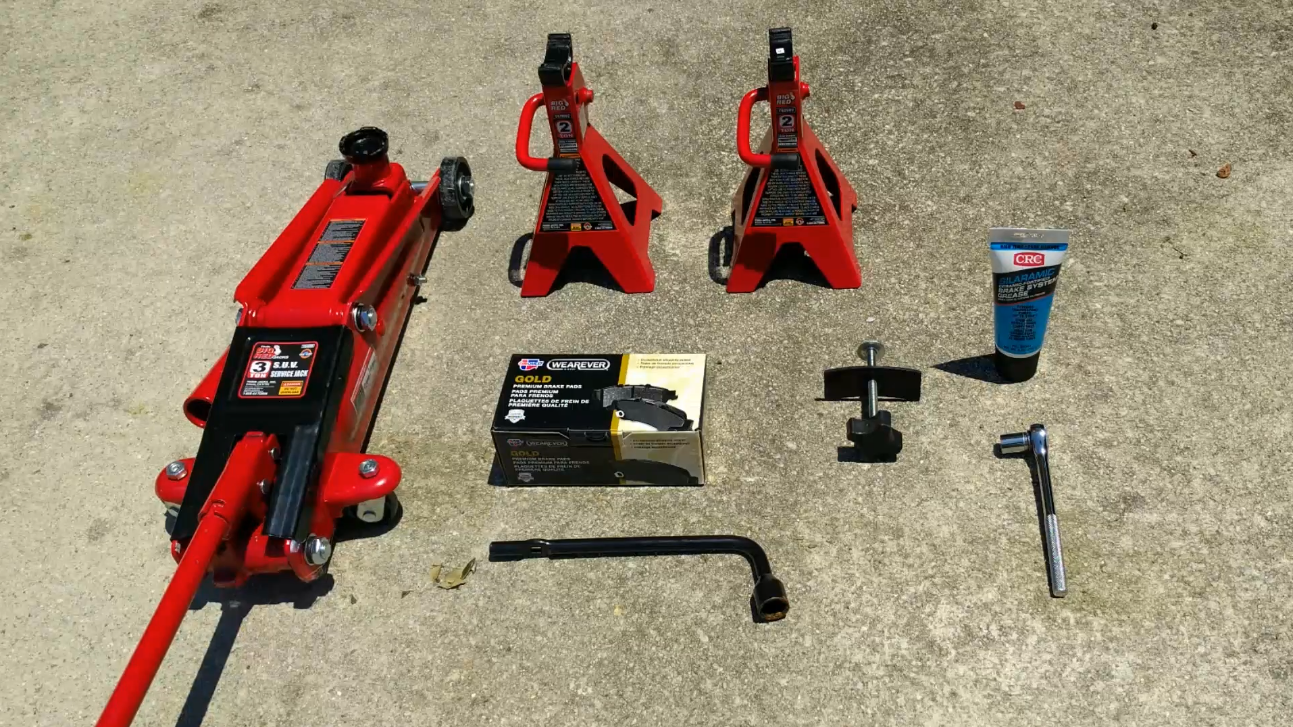
Before you get started, you’ll need a few tools. Some of these are the kind you probably have around the house, but a few may require a trip to the auto parts store. The upfront cost of some of these tools is high, but you can use them forever. Over the long run, you’ll save more money by getting them now, and doing your own repairs in the future.
- Owner’s manual: Any time you repair your car yourself, make sure you have your owner’s manual handy. For this repair, your manual will be helpful for finding your car’s jack points, weight and minimum rotor thickness among other things. If you don’t have it or can’t find it, a quick search for your model number will turn up a PDF, guaranteed.
- Floor jack: The jack that comes with your car is fine for changing a spare tyre, but for this kind of maintenance you’ll want a floor jack. To be safe, get a jack that’s rated for at least three-fourths of your car’s total weight (the jack will only lift about half the car, but better safe than sorry — or injured). The vehicles I worked on are between one to two tonnes each, but I got a three-tonne jack to be on the safe side and give myself some flexibility to work on heavier vehicles.
- Jack stands: Once your car is jacked up, you’ll need jack stands to keep it in the air. Each jack stand is individually rated based on how much weight it can handle, but you’re going to want to use them in pairs. Again, overestimating is better. The vehicles I worked on max out at 1.5 tonnes, so I opted for a pair of two-tonne stands.
- Brake tool: This tool adjusts your brake caliper piston to the new brake pads. Adjusting the caliper piston isn’t impossible without this tool, but it’s super cheap and it’s much safer than most other workarounds.
- Replacement brake pads: Obviously, you’ll need new brake pads to replace your old ones. Most auto parts stores will be able to help you find the right pads for your vehicle.
- Replacement rotors (if necessary): In some situations, you may need to change your rotors at the same time you change your brake pads. Pads and rotors both wear down, but they don’t necessarily wear down evenly. In your owner’s manual, you’ll find your rotors’ minimum recommended thickness. If your rotors get below this value, you should replace them.
- Brake grease: This grease is applied to the surface of your brake pads between the pads and the calipers.
- Specific instructions for your car: Changing brake pads is a pretty straightforward task, but some car models may be different. If you encounter something on your car that looks different than our guide, check your owner’s manual. If your owner’s manual isn’t clear on the details, you can almost always find a helpful YouTuber with a video of a brake pad change on your specific car. Check it out before you get under your car to make sure you know what you’re looking for.
- Socket wrench
- Tyre iron
If this is your first time working on your car, don’t baulk at the first-time investment. In my case, it cost around $140 for the tools I didn’t already own, plus $40 for the replacement pads. You should also expect that it will take a few extra hours to learn what you’re doing. That’s OK, take it slow and make sure you’re doing everything right, or talk to someone who can help.
Once you own the tools and know what you’re doing, though, you can replace your brake pads on the cheap in a single afternoon in your garage. Then there are all the other car repairs you can do yourself with the same tools.
Step 1: Get Your Car Off the Ground
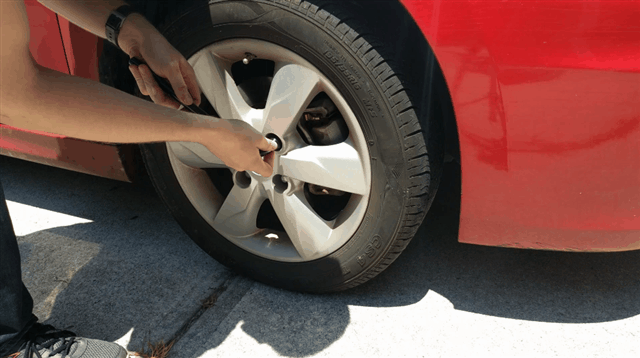
You’ll need to remove your tyres in order to get to your brake pads. If you’ve ever changed a flat tyre, the first part of this process should be familiar. Start by using your tyre iron to loosen the lug nuts on the wheels where you’re replacing the brake pads (typically you should be doing this in pairs, so either both front tyres or both back tyres). You’ll need to loosen the lug nuts before you lift the car because otherwise your wheels will just spin in the air.
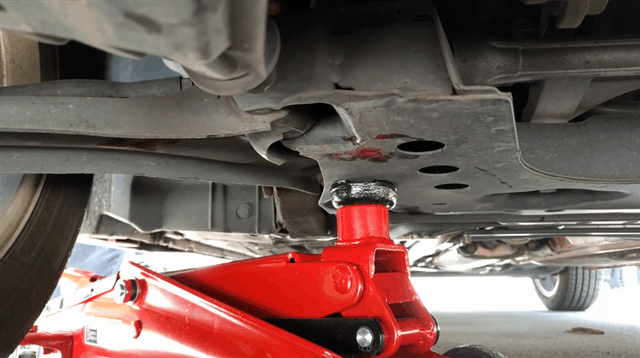
Once the lug nuts are loose, it’s time to jack up your car. Your owner’s manual should tell you where it is safe to place a jack underneath your car. Some cars have a jack point specifically for floor jacks, while others will simply use the jack points on the side of your vehicle that you would use to change a flat tyre. Once you’ve located your jack point, lift your car with the jack (if you’ve never used a floor jack before, check out this guide over on Jalopnik on how to use one).
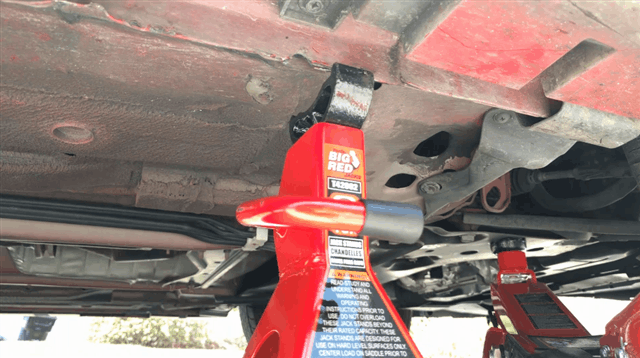
Next, place the jack stands underneath a solid, structural piece of the vehicle’s frame. Once again, your manual can give you specifics. When the stands are in place, slowly lower your vehicle until it is safely resting on the jack stands, then remove your floor jack. Now, you can finish unscrewing the lug nuts and remove the tyre from your car.
Step 2: Remove the Caliper Assembly and Old Brake Pads
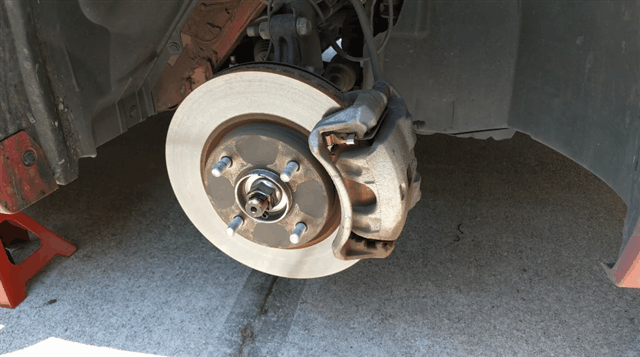
At this point, you should see your rotor and brake caliper assembly. The caliper assembly acts as a clamp, squeezing your brake pads against your rotors, which slows your wheels down so you don’t careen into walls. Using a socket wrench, remove the bolts on the back of the caliper assembly.
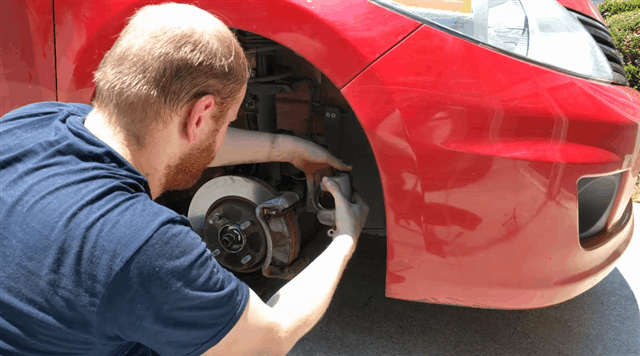
Now slide the caliper assembly off of the rotor. Note that the assembly will still be attached to the brake line. Do not hang the caliper by the brake line. Gently set the caliper on top of the rotor, or use a piece of wire to hang it from the wheel well. Make sure it is completely supported and won’t fall before moving on. If the caliper drops, it could snap the brake line, which will be much more expensive to fix.
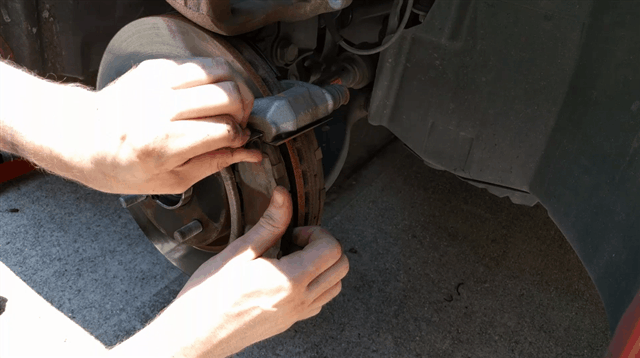
At this point, you can remove the brake pads from the rotor. Depending on your car, these may either slide or pop out. Be careful not to damage any of the clips, or the rotor itself, especially if you plan to continue using the same rotor. If your brake pads came with extra clips, you may also want to remove the old clips and replace them with the new ones. As you remove the pads, keep track of how they are oriented in the brake assembly to make it easier to insert them correctly in the next step.
Step 3: Replace the Brake Pads
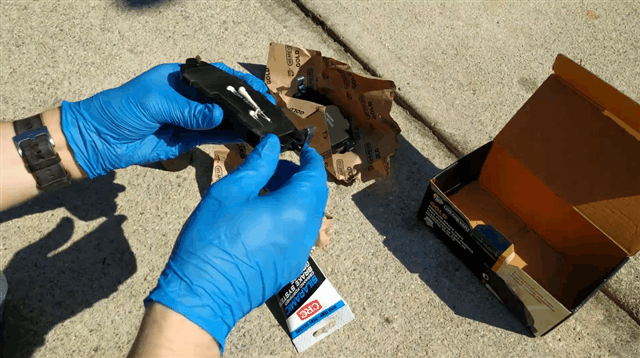
Now that the old brake pads have been removed, you can put in the new ones. First, apply the brake grease to the backs of the pads. When you press your brakes, the caliper piston will press against the backs of your brake pads, which can cause an annoying squeaking sound. This brake grease helps reduce that noise. Be careful not to get grease on the front of the brake pads or the rotors. Your brakes depend on friction between the pads and rotors to slow your vehicle. Getting grease in between these two parts defeats that purpose and can potentially harm you or your vehicle.
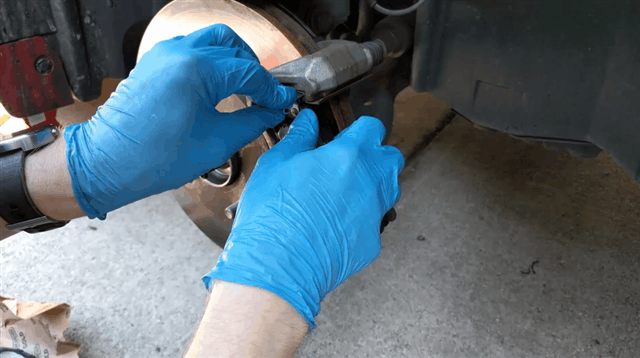
Once you’ve applied the brake grease, place the new brake pads in the same spot that you removed the old pads. If you’re doing this for the first time, try replacing one brake pad at a time so you can see exactly where each part goes before moving on to the next one.
Step 4: Replace the Brake Caliper Assembly
Once your new brake pads are in place, you’ll need to replace your caliper assembly. You might notice that the assembly no longer fits on top of your brake pads. This is because as your brake pads wear down, the piston inside the caliper assembly will adjust to their smaller width. You’ll need to use your brake tool to fix this.
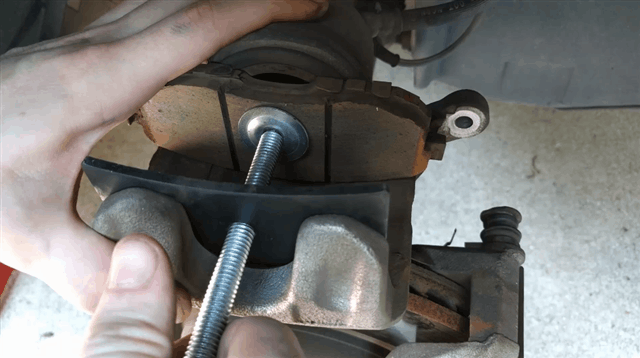
First, place one of your used brake pads inside the caliper assembly against the large circular piston. Then, place the wide plastic piece of the brake tool against the opposite side of the caliper. Rotate the handle on the brake tool to compress the piston back into the caliper assembly until it is fully retracted.
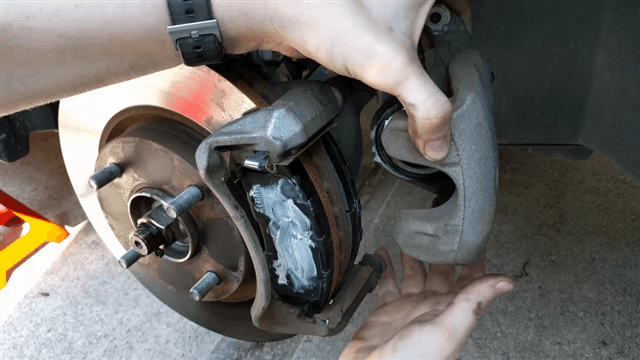
You may also need to compress the pins where your caliper assembly bolts screw into. Once that’s done, you can place the caliper assembly onto your brake pads. Insert the assembly bolts and tighten them down with your socket wrench.
Step 5: Replace Your Tyres and Wrap It Up
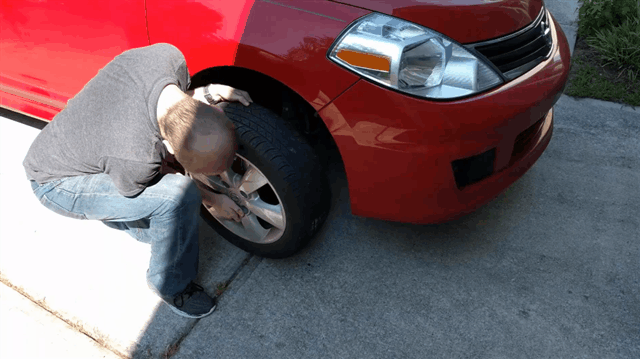
Double-check to make sure that everything is tight and sealed securely before you replace your tyre. Once you’re ready, place your tyre back on your rotor and hand tighten the lug nuts to keep the tyre in place. Place your jack underneath your car on the jack points and lift the vehicle off of the jack stands. Remove the jack stands from underneath your vehicle, then slowly lower the vehicle back down to the ground.
Once the car is on the ground, you can use your car’s tyre iron to securely tighten the lug nuts. Take extra care during this step to make sure that the lug nuts are snug, without stripping them. If you have a torque wrench, use it to make sure your lug nuts are tightened appropriately. You don’t want your tyres to start wobbling or fall off once you hit the road again.
If this is your first time replacing your brake pads, try driving your car around the block once or twice, testing the brake pads at low speeds. If you hear any squeaking or scraping, lift your car again and make sure everything is securely in place.
While it might seem intimidating, changing your brake pads is a ridiculously easy process that nearly anyone can do with the right tools. Once you get used to doing it, you can replace your brake pads in an hour or so. Not to mention, you can save hundreds of dollars over the long run by doing the job yourself.
This story has been updated since its original publication.
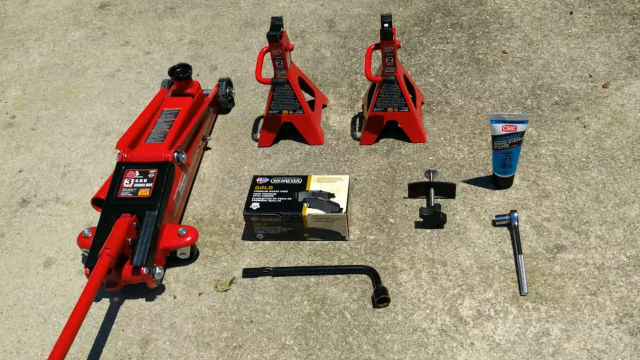
Comments
9 responses to “How To Change Your Car’s Brake Pads”
A few suggestions if you haven’t done this before:
1) Get a friend to help. Even if they only watch and tell you things like “hey, don’t you think it would be a good idea to chock those wheels?” or they may see something you don’t (like a nut) or what you are doing wrong.
2) Looks like a good intro but I suggest go to Youtube and search for your car and model. That can be extremely helpful. You can spend a lot of time undoing bolts that you don’t need to or not know about a bolt that comes from the rear of the caliper. I had to attack my rotors with a hammer to get them off because of rust, if I hadn’t see a guy do that on youtube I would have been stuck. (and this was the fifth time I have changed pads/rotors on a car, but every car can be a little different) I also took the advice to apply ant-seize compound on those mating surfaces when I replaced it.
3) “Getting grease in between these two parts defeats that purpose and can potentially harm you or your vehicle.” Buy some brake pad cleaner, just in case, to clean it off if this happens.
4) Don’t be afraid. It is pretty easy – most times.
5) Don’t open the bleed valve, use a brake spreader as suggested above, it will be much easier.
you need to open the bleed valve to actually use the brake spreader, its not a one or the other choice.
So you will also need a brake bleeder kit if youre doing it by yourself, but definitely easier to get a friend to help.
And no – you don’t use the brake spreader with the actual brake pads, and considering that some callipers have a leadscrew type action to push the callipers back, you are just going to bend/break the tool, the callipers actually need to turn
If you follow this guide you will get to step 4 and wont be able to continue, and seeing as brake fluid and a bleeder kit arent on the list, when you do open the bleeder valve after trying everything else, you wont have any way to bleed the brakes or top up the fluid, good luck stopping the car with air in the lines.
I’ve never opened the bleed valve to compress the pistons back into the bores, just used any kind of clamp or multigrip on the old pads to push back the pistons before removing the old pads. The fluid displaced just ends up back in the master cylinder, job done.
+1 for Lexx – I’ve done this a bunch of times; push pistons back with a dirty great screwdriver (fluid flows back up into master cylinder), pull pads, replace them and then pump the brakes to bring pads back in contact with rotor. Simples. And if you leave the brake bleeder nipples alone, you won’t introduce air into the system.
I use a C-clamp and a stack of 8 tazos taped together, works great!
As pointed out above, if you don’t open it then air won’t get it. The only reason to open it is to make it easy to push the piston back, and its easy because you are letting the air in. You are right, do this before removing the old pads.
You can use a G-clamp or big pliers instead of a caliper spreader but the spreader is pretty cheap and just makes it easy, esp. if you haven’t done it before. A spreader will cost you about the same as a small bottle of brake fluid, which you will definitely need if you have to bleed the brake line. You will also need a brake bleed kit if you don’t have a friend to help.
This is one of those things where, yes, I could possibly do it, but as I feel I don’t really know enough about the systems I’d rather get someone who actually knows what they’re doing so I don’t die. I’m not going to take any risk whatsoever with my brakes.
Changing a tyre in a pinch is one thing but changing a brakepad is another. That’s a serious safety concern if you happen to get it wrong so I would advise you don’t do it yourself unless you have some who knows what they are doing teach you how.
This technique will work on the front but will not work on the rear of many modern cars which require a caliper wind back tool rather than just a brake spreader.
100% not something i’d advise any of my friends or family do without a decent amount of knowledge.